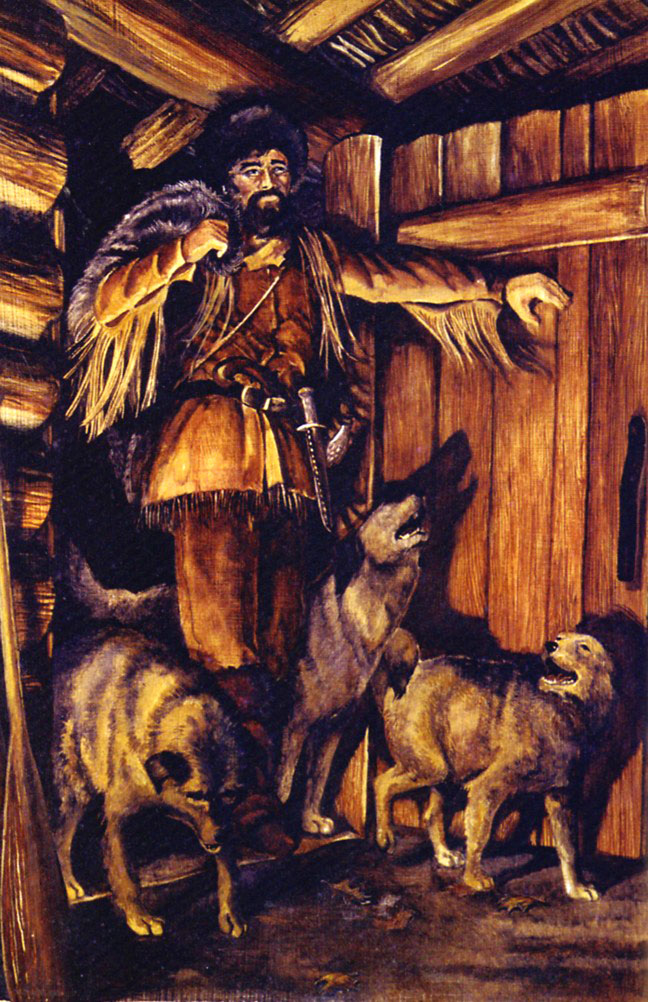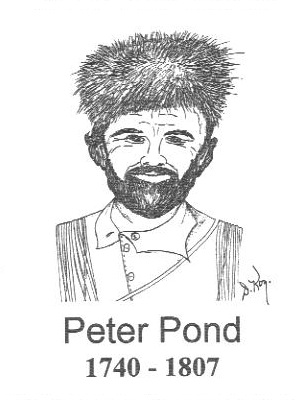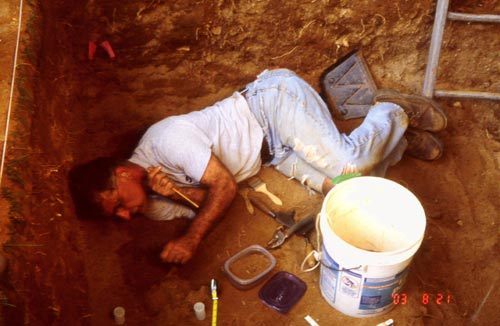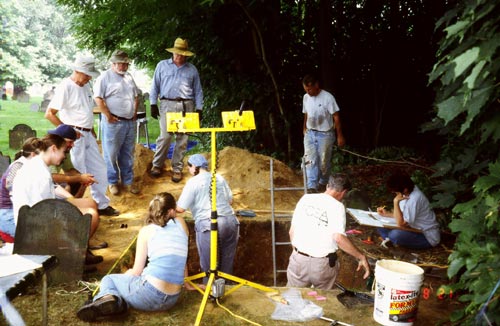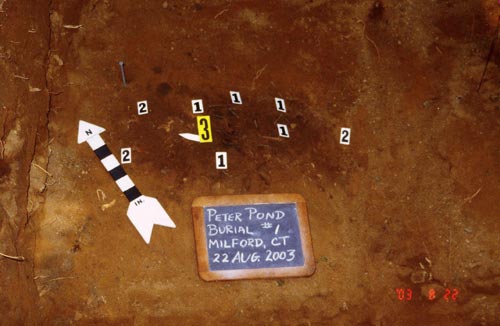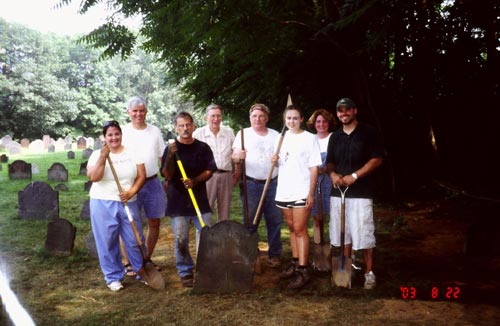Peter Pond newsletter :: October 2003 :: #17
SEARCHING FOR Peter Pond's UNMARKED GRAVE
Hello again. I hope everyone is enjoying a pleasant fall as the weather around here in mid-October is just starting to get nippy and the leaves changing color.
Time has come to dwell more on those three sultry days in August when a fine collection of almost two dozen knowledgeable, concerned, dedicated people came together to help Peter Pond Society pursue its classic goal: find the unmarked grave of Peter Pond.
As you remember, I sent you the flash message on August 22, the third and final day of the search, that we were unsuccessful. What follows is a little more detailed discussion of those three days complete with six images culled from two rolls of slides I took Two Connecticut Post stories are included here along with the Channel 8-TV story script, video replay and a list of everyone who worked on the dig.
We worked in a seven-by-seven foot square next to the grave of Mary Pond, Peter's mother, the same area marked out in a ground penetrating radar scan two years ago that showed evidence of "disturbed earth" and two possible unmarked graves. What we found were three children ranging in size from 17 inches to three feet long. So the earth had indeed been disturbed, but not for the reason we hoped.
Apparently infant mortality in colonial days was common to the extent that putting babies in unmarked graves was not unusual. But we think we have names for all three. The theories, as stated in the Post story, is they are: Charlotte Pond, Peter's niece who has a stone next to Mary. The other could be Jedediah Pond, the last of Mary's nine children (Peter being the first) who died around two months old. The third could be Joel Hepburn, infant son of Susanna Hepburn who has a stone on the other side of our square from Mary Pond.
The atmosphere was expectant if not downright tense through the three days. The weather was sunny, warm and humid but thankfully all the work was done in shade next to a tree line separating the edge of the cemetery from railroad tracks. Dr. Nick Bellantoni, state archeologist who assembled this fine crew, was a tireless worker with both shovel and getting close with a whiskbroom when burials started becoming apparent. What he found was interesting, and he took some samples back to a lab for further testing. As he said during one of the rest breaks: "Sometimes we've dug for two days and found not so much as a chip."
The "chip" reference was that we found pieces of "worked stone" that had been apparently fashioned by Indians while making arrowheads. This came out in sifting the dirt dug up from our pit, showing the spot was probably an Indian encampment once and chips had been part of the earth used in filling in graves.
But what impressed Nick the most was the first burial on the apparent 17-inch long body, likely a premature baby, found around 2 p.m. the first day. It had 20 pins used to hold together a shroud that had long since decomposed. Only pieces of bone were left. Nick had never seen so many shroud pins on a body. None were rusted. He took several back to the lab to determine if they were pre or post 1820. If made after 1820 then the burials would not be the three who we named. I'm told that bodies were never buried wearing clothes which could be sold at good prices ie. you'd get $4 for a highboy but $8 for a great coat.
The next burial also about three feet down and a foot away revealed only coffin nails arranged about three feet long with nothing more than part of a skull with some teeth, found around 3 p.m. the first day. A look at a tooth chart determined this person was about three years old.
Nick and his crew spent most of the next day cleaning around and documenting those two burials ie. making sure they were only children and making a chart or map of their description and location in the hole we were digging.
Another foot away and six inches further down was the third grave, about two feet long judging by the outline of the several coffin nails. But no bones or fragments were found in this discovery around 10 a.m. of the third day.
Each time we came on a burial, excitement rose until we saw that each was only a child or infant.
In the end, we left plastic over the first two burials as a sign of respect and show someone had dug there, for any similar archeological dig in the future. But plastic was not put over the third burial since we found no bones there, only nails. The hole was quickly filled back up. All dirt had been placed on plastic sheets covering the ground. Grass squares taken off the top were the last to be put back. So there was minimal evidence of an excavation when we left the site, sign of a caring, scientific operation from start to finish.
People ask me if I was disappointed. Well, yes, but not shattered. The evidence prompting a dig on this spot was not that solid, but still compelling. So we dug and found it was the wrong place. People gave me some ideas of where to look for more information ie. probate records saying how Peter Pond's property was ultimately disbursed and perhaps his grave location as well. Or try to find an old obituary. Maybe I should have done this early on, but I thought what I had was pretty good at the time. I'm only an amateur historian. If I ever try to organize another dig, the evidence will have to be compelling all over again. Nick has told me to keep in touch. He expects to file his own report on the project by the end of the year.
Here are the dig participants, besides Dr. Bellantoni and me (should also be noted Milford Historian Richard Platt visited several times during the dig and brought documents helping in possible identification of the burials; Milford Cemetery Association President Robert Beard visited after giving kind permission for the project; and Cemetery Director Ray Scholl helped in digging, filling and providing extra tools including a portable generator for better lighting.)
(1) Barbara Kipfer, Essex, archeologist, archeological writer and lexicographer (one who writes dictionaries and thesauruses); (2) Kyle Kipfer, her son, senior at Valley Regional High School, Deep River; (3) Eric Conrad, West Haven, fifth grade teacher at Calf Pen Meadow Elementary School, Milford, Southern Connecticut State University graduate student for master's degree in Science Education participating in dig for his degree's mentor program; (4) Audrey McClure, North Haven, member of the Arthur Basto Archeological Society who has worked with Nick on past digs; (5) Kathryn Etre, Vernon, archeology undergraduate student at Boston University who had emailed Nick on how she could help over the summer and was invited to this; (6) Cynthia Redman, Windsor, member of the Friends of the State Archeologist (FOSA); (7) Mary Murray, Killingworth, sixth grade teacher at Lyme-Old Lyme Middle School pursuing Science Ed. master's degree at SCSU and, like Conrad, using this as mentorship project; (8) Kathleen Richard, Cheshire, fifth grade teacher at Roger Sherman School, Meriden, also SCSU Science Ed. Master's degree candidate in mentorship; (9) Ruth Shapleigh-Brown, Manchester, Connecticut Gravestone Network executive director.
Also: (10) John Spaulding, Manchester, Connecticut Gravestone Network research clearinghouse coordinator; (11) Peter Bass, Colchester, FOSA volunteer; (12) Jackie Nadeau, Meriden, University of Connecticut anthropology major who works in Nick's office and has been a dig volunteer since her high school junior year; (13) Hank Coppes, Westbrook, FOSA member; (14) Samantha Cox, Mendham, N.J., entering sophomore year at Mendham High School, doing summer internship with Dr. Nick; (15) Paul Scannell, East Windsor, FOSA member; (16) Dick LaRose, Windsor Locks, FOSA and Arthur Basto member; (17) David Cooke, Rocky Hill, FOSA, has been doing this work 40 years with Nick and his predecessor, Dick Jordan; (18) Jack Rajotte, Groton, FOSA; (19) George Kinsella, Hartford, FOSA.
Also: (20) Kristen Batis, Windsor Locks, UConn archeology graduate student; (21) Renee Petrucelli, Avon, anthropology graduate student at University of Alaska/Anchorage about to transfer to UConn; and (22) Roger Thompson, South Windsor, FOSA.
Explorer's grave yields only children
By FRANK JULIANO
Connecticut Post
Friday, August 22, 2003
It's not a trick question: Who's buried in Peter Pond's grave?
A team of archaeologists, students and amateur historians has found the remains of two children in the Milford burial plot believed to be Pond's, but so far there is no sign of the 18th century explorer-entrepreneur.
The team headed by State Archaeologist Nick Bellantoni opened the Milford Cemetery grave, next to the marked plot of Pond's mother, Mary, on Wednesday, and worked through Thursday on a meticulous search.
The eight-member team is expected to wrap up its work today.
Bellantoni squatted inside the 4-foot excavation, using paintbrushes, a whisk broom and a magnifying glass to search for artifacts and remains, while assistant Renee Petruzelli plotted the dig on graph paper.
One of the bodies is almost certainly that of an infant who lived only a few days, said William McDonald of Milford, president of the 90-member Peter Pond Society and a Connecticut Post sports reporter.
"We have two theories on who it might be," McDonald said. "It could be Mary's daughter, and Peter's sister, Charlotte, or Jedediah Pond."
Mary Pond had eight children, and Charlotte and Jedediah were the last two, according to the family genealogy. Charlotte died in June 1761, two months before Jedediah was baptized. The only notation in the Pond family genealogy for him is "D.Y.," for died young.
The second body is nearly 36 inches long and has a skull with teeth, Bellantoni said, indicating that the child was about age 3 at death.
The smaller body was wrapped in a shroud, the archaeologist said. Although that material has long rotted away, several copper "shroud pins" outlined its placement.
The larger body was buried in a small coffin. Bellantoni's team found a small piece of the wooden box and several nails from the coffin. Since the gender of either body can't be determined, it is likely that one is Charlotte and the other is Jedediah, researchers concluded.
So where is Peter Pond? McDonald said the explorer died in 1807 in Milford, "and if he is not in the family plot, I have no idea where his final resting place may be."
Pond, a Milford native, is credited with opening northwest Canada to exploration, but was also charged with two murders, McDonald said. The explorer was not convicted in either case.
Members of Pond's company, the Northwest Fur Trading Co. though not Pond himself reached the Pacific Ocean before Lewis and Clark mapped the American west on their famous trip, society members said.
Pond died broke after squandering his profits from the lucrative fur trade, McDonald said. The society would like to erect a suitable grave marker for the explorer. The Ponds are one of Milford's founding families and also have contributed a state governor and a Revolutionary War hero.
Among the volunteers at the excavation Thursday was 15-year-old Samantha Cox, who came from New Jersey to assist "Dr. Nick." "I like to study different customs and lifestyles and how things have changed," the aspiring archeologist said.
Kathryn Etre, of Vernon, an archaeology student at Boston University, was patiently sifting sand in a screen box, a process that had already yielded several projectile points sharpened pieces of quartz that had been used as arrowheads, ax blades or other tools by American Indians.
The finds clearly indicate that local Indians camped on what is now the Milford Cemetery, between Gulf and Prospect Streets, said Etre and archaeologist Jack Rajotte.
It is not unusual to find items so old so close to the surface, Rajotte said, since when graves are dug the soil is disturbed and replaced so that the layers indicating time are mixed together.
Frank Juliano, Milford bureau chief, can be reached at 878-2130.
3rd child's body found in grave but Peter Pond remains elusive
By DIRK PERREFORT
Connecticut Post
Saturday, August 23, 2003
MILFORD - Peter Pond's final resting place remains a mystery.
Archaeologists on Friday afternoon wrapped up an excavation at Milford Cemetery, where locals hoped Pond was laid to rest when he died in 1807.
The unmarked grave excavated was adjacent to the burial plot of Peter's Pond's mother, Mary.
"Based on historical research and ground-penetrating radar this spot was our best guess," said State Archaelogist Nick Bellantoni. "Where he is now we don't have a clue."
Pond, a city native, is credited with opening northwest Canada to exploration and was also charged with two murders, although he was never convicted. Members of Pond's company, Northwest Fur Trading Co., but not Pond himself, reached the Pacific Ocean before Lewis and Clark.
Despite not finding Pond's body, archaeologists did unearth three children buried in the grave.
William McDonald, president of the Pond Society and a Connecticut Post sports writer, theorized that two of the bodies were Charlotte Pond, Peter Pond's niece, and Jedediah Pond, Peter Pond's brother.
The third child, found on Friday, could be that of Joel Hepburn, according to City Historian Richard Platt.
He said that Susannah Hepburn, whose grave is next to the one being excavated, had a son Joel, who died at a young age in 1757.
There was very little left of the children's remains, which, Bellantoni said, isn't a surprise.
"Because of the acidity in the state's soil most bodies only last 200 to 300 years before becoming part of the earth," he said. "And children have bones that are less dense so they decompose quicker. It's remarkable that there is any bone left at all."
McDonald said not finding Pond was definitely a disappointment. "We gave it a good try," he said.
"There are some other ideas I want to pursue."
Platt noted that it could be difficult to locate Pond's body because many graves in the cemetery were moved when railroad tracks were installed through the site.
"Mary's footstone is about seven feet away from her headstone and on an angle," he said.
"It appears as though it is among the graves that were moved."
Dirk Perrefort, who covers Milford, can be reached at 878-2130.
Digging for Peter Pond's grave
(Milford-WTNH, Aug. 22, 2003 6:10 PM) _ He fought in the French and Indian War. In 1778 he had gone further west in America than any other white man. But when Peter Pond died in his hometown of Milford his grave wasn't marked. This week, archaeologists went back in time and down in the ground to search for Pond's grave.
This was a story by News Channel 8's Kent Pierce
It's a search party for a missing explorer. 18th century adventurer Peter Pond was born and died in Milford, but there's no gravestone.
For three days Dr. Nick Bellantoni, the state archaeologist, and his team dug up a section of the Milford Cemetery near where Peter's mother Mary was buried. On day two they found an unmarked grave.
"What we started to get were coffin hardware and a dark stain…" Dr. Bellantoni said.
You can see the pins that would have fastened the burial shroud. The problem is, the outline is only big enough for an infant.
However, at that child's feet was another body. You can see teeth and the outline of a skull, but the skull is only big enough for a four year old.
Then on the final day of searching, another grave.
"All organic remains were completely gone," Dr. Bellantoni said. "Nothing other than a pattern of nails that allowed us to outline the coffin."
But again, the outline was too small to be the fur trader who went to Canada and gave directions to Alexander MacKenzie, the first European to reach the Pacific by land, or the Peter Pond whose maps convinced Thomas Jefferson to send Lewis and Clark to explore the west. "I guess we've learned that Peter Pond apparently is not buried there," said Milford town historian Richard Platt.
One problem is, just after Peter Pond died, they built railroad tracks right next to the cemetery. Tombstones could have been moved and graves could have been covered up."
"It's always been a shame that he never had a marker," said Bill McDonald, President of the Peter Pond society.
Two years ago, McDonald brought in ground-penetrating radar, and discovered there were unmarked graves that might be Pond.
"He has a big monument to him in Prince Albert, Saskatchewan. Back in his own hometown, there's not even a headstone," McDonald said.
Town historian Richard Platt thinks two of the bodies found are relatives of Pond. "So we still don't know where the man was buried," he said.
"I'm coming away with more than I knew before," says McDonald, and he plans to keep looking for clues to Pond's grave.
Coffin nails and a few teeth will be tested in labs, but mostly the remains were left intact and the graves were filled back in.
DIG PHOTOS
Finally, here are captions for the six attached photos:
Among the early arrivals on the first day prior to breaking ground next to Mary Pond's headstone are, from left: Milford Cemetery director Ray Scholl, Kyle Kipfer, Barbara Kipfer, Eric Conrad and Dr. Nick Bellantoni.
Dr. Nick Bellantoni doing careful work about three feet down on one of the three child burials that were found. Small film canisters are for collecting some shroud pins and coffin nails for later laboratory examination.
Some of the close to two dozen participants who helped out during all or part of the three-day project surround the seven by seven-foot excavation. Yellow object in foreground is generator-powered lighting provided by Milford Cemetery Association.
Close-up of first of three child burials found, about 17 inches long, most likely a premature infant. Black and white numbers are for each of the many shroud pins found, some of which may be visible in the image.
Reporter Kent Pierce and cameraman J.P. Coleman of ABC affiliate WTNH-TV Channel 8, New Haven, record the project for a story that aired later that evening. Both did the two other previous Peter Pond Society stories for Channel 8. News Channel 12, Norwalk, a local cable station, also did a story on this August project.
The excavation site has been well covered up at the end of the three-day project in August 2003. From left: Jackie Nadeau, Bill McDonald, Dr. Nick Bellantoni, David Cooke, Peter Bass, Kathy Etre, Kristen Batis and Eric Conrad.
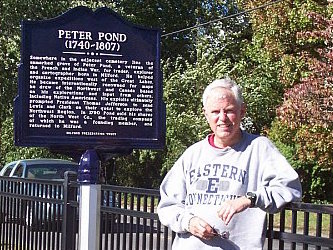
Au revoir,
Bill
website design by Daniel Ortoleva
